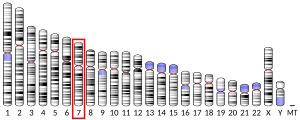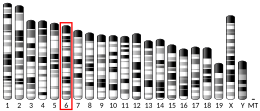ZC3HC1
| ZC3HC1 | |||||||||||||||||||||||||||||||||||||||||||||||||||
|---|---|---|---|---|---|---|---|---|---|---|---|---|---|---|---|---|---|---|---|---|---|---|---|---|---|---|---|---|---|---|---|---|---|---|---|---|---|---|---|---|---|---|---|---|---|---|---|---|---|---|---|
| Identifiers | |||||||||||||||||||||||||||||||||||||||||||||||||||
| Aliases | ZC3HC1, NIPA, HSPC216, zinc finger C3HC-type containing 1 | ||||||||||||||||||||||||||||||||||||||||||||||||||
| External IDs | MGI: 1916023; HomoloGene: 32315; GeneCards: ZC3HC1; OMA:ZC3HC1 - orthologs | ||||||||||||||||||||||||||||||||||||||||||||||||||
| |||||||||||||||||||||||||||||||||||||||||||||||||||
| |||||||||||||||||||||||||||||||||||||||||||||||||||
| |||||||||||||||||||||||||||||||||||||||||||||||||||
| |||||||||||||||||||||||||||||||||||||||||||||||||||
| |||||||||||||||||||||||||||||||||||||||||||||||||||
| Wikidata | |||||||||||||||||||||||||||||||||||||||||||||||||||
| |||||||||||||||||||||||||||||||||||||||||||||||||||
Nuclear-interacting partner of ALK (NIPA), also known as zinc finger C3HC-type protein 1 (ZC3HC1), is a protein that in humans is encoded by the ZC3HC1 gene on chromosome 7.[5][6] It is ubiquitously expressed in many tissues and cell types though exclusively expressed in the nuclear subcellular location.[7][8] NIPA is a skp1 cullin F-box (SCF)-type ubiquitin E3 ligase (SCFNIPA) complex protein involved in regulating entry into mitosis.[9] The ZC3HC1 gene also contains one of 27 SNPs associated with increased risk of coronary artery disease.[10]
Structure
[edit]Gene
[edit]The ZC3HC1 gene resides on chromosome 7 at the band 7q32.2 and includes 14 exons.[6]
Protein
[edit]NIPA is a 60-kDa E3 ligase that contains one C3HC-type zinc finger and one F-box-like region.[11][12][13] Moreover, a 50-residue region (amino acids 352-402) at its C-terminal serves as the nuclear translocation signal (NLS sequence) while a 96-residue region (amino acids 306-402) is proposed to serve as the phosphotyrosine-binding domain.[9][11] NIPA is one component of the nuclear SCFNIPA complex, and phosphorylation of NIPA at three serine residues, Ser-354, Ser-359 and Ser-395, has been demonstrated to inactivate the complex as a whole.[9]
Function
[edit]NIPA is broadly expressed in the human tissues, with the highest expression in heart, skeletal muscle, and testis.[11] It is a human F-box protein that defines an SCF-type ubiquitin E3 ligase, the formation of which is regulated by cell-cycle-dependent phosphorylation of NIPA. Cyclin B1, essential in the entry into mitosis, is targeted by SCFNIPA in interphase. Phosphorylation of NIPA occurs in G2 phase, results in dissociation of NIPA from the SCF core, and has been proven critical for proper G2/M transition.[8] Oscillating ubiquitination of nuclear cyclin B1 driven by the SCFNIPA complex contributes to the timing of mitotic entry.[9][14] NIPA is also reported to delay apoptosis and the localization of NIPA is required for this antiapoptotic function.[11]
Clinical relevance
[edit]In humans, NIPA has been implicated in cardiovascular diseases by genome-wide association (GWAS) studies. Specifically, a single-nucleotide polymorphism (SNP) situated in ZC3HC1 has been shown to predict coronary artery disease.[15][16] This prediction appears to be independent of traditional risk factors for cardiovascular disease such as high cholesterol levels, high blood pressure, obesity, smoking and diabetes mellitus, which are primary targets of current treatments for coronary artery disease. Therefore, studying the function of this gene may identify novel pathways contributing to coronary artery disease that result in the development of novel therapeutics.
Clinical marker
[edit]At the coronary artery disease-associated locus 7q32.2, only a single SNP (rs11556924) is associated with coronary artery disease risk, with no other variants in strong linkage disequilibrium. The rs11556924 SNP in the ZC3HC1 gene results in an arginine-histidine polymorphism at amino acid residue 363 in NIPA.[17] Furthermore, rs11556924 has also been associated with altered carotid intima-media thickness in patients with rheumatoid arthritis[18] and with altered risk of atrial fibrillation.[19]
Additionally, a multi-locus genetic risk score study based on a combination of 27 loci, including the ZC3HC1 gene, identified individuals at increased risk for both incident and recurrent coronary artery disease events, as well as an enhanced clinical benefit from statin therapy. The study was based on a community cohort study (the Malmo Diet and Cancer study) and four additional randomized controlled trials of primary prevention cohorts (JUPITER and ASCOT) and secondary prevention cohorts (CARE and PROVE IT-TIMI 22).[10]
References
[edit]- ^ a b c GRCh38: Ensembl release 89: ENSG00000091732 – Ensembl, May 2017
- ^ a b c GRCm38: Ensembl release 89: ENSMUSG00000039130 – Ensembl, May 2017
- ^ "Human PubMed Reference:". National Center for Biotechnology Information, U.S. National Library of Medicine.
- ^ "Mouse PubMed Reference:". National Center for Biotechnology Information, U.S. National Library of Medicine.
- ^ Zhang QH, Ye M, Wu XY, Ren SX, Zhao M, Zhao CJ, Fu G, Shen Y, Fan HY, Lu G, Zhong M, Xu XR, Han ZG, Zhang JW, Tao J, Huang QH, Zhou J, Hu GX, Gu J, Chen SJ, Chen Z (October 2000). "Cloning and functional analysis of cDNAs with open reading frames for 300 previously undefined genes expressed in CD34+ hematopoietic stem/progenitor cells". Genome Research. 10 (10): 1546–60. doi:10.1101/gr.140200. PMC 310934. PMID 11042152.
- ^ a b "Entrez Gene: ZC3HC1 zinc finger, C3HC-type containing 1".
- ^ "BioGPS - your Gene Portal System". biogps.org. Retrieved 2016-10-11.
- ^ a b Bassermann F, von Klitzing C, Münch S, Bai RY, Kawaguchi H, Morris SW, Peschel C, Duyster J (July 2005). "NIPA defines an SCF-type mammalian E3 ligase that regulates mitotic entry". Cell. 122 (1): 45–57. doi:10.1016/j.cell.2005.04.034. PMID 16009132. S2CID 16122567.
- ^ a b c d Bassermann F, von Klitzing C, Illert AL, Münch S, Morris SW, Pagano M, Peschel C, Duyster J (June 2007). "Multisite phosphorylation of nuclear interaction partner of ALK (NIPA) at G2/M involves cyclin B1/Cdk1". The Journal of Biological Chemistry. 282 (22): 15965–72. doi:10.1074/jbc.M610819200. PMID 17389604.
- ^ a b Mega JL, Stitziel NO, Smith JG, Chasman DI, Caulfield MJ, Devlin JJ, Nordio F, Hyde CL, Cannon CP, Sacks FM, Poulter NR, Sever PS, Ridker PM, Braunwald E, Melander O, Kathiresan S, Sabatine MS (June 2015). "Genetic risk, coronary heart disease events, and the clinical benefit of statin therapy: an analysis of primary and secondary prevention trials". Lancet. 385 (9984): 2264–71. doi:10.1016/S0140-6736(14)61730-X. PMC 4608367. PMID 25748612.
- ^ a b c d Ouyang T, Bai RY, Bassermann F, von Klitzing C, Klumpen S, Miething C, Morris SW, Peschel C, Duyster J (August 2003). "Identification and characterization of a nuclear interacting partner of anaplastic lymphoma kinase (NIPA)". The Journal of Biological Chemistry. 278 (32): 30028–36. doi:10.1074/jbc.M300883200. PMID 12748172.
- ^ Kunnas T, Nikkari ST (August 2015). "Association of Zinc Finger, C3HC-Type Containing 1 (ZC3HC1) rs11556924 Genetic Variant With Hypertension in a Finnish Population, the TAMRISK Study". Medicine. 94 (32): e1221. doi:10.1097/MD.0000000000001221. PMC 4616712. PMID 26266351.
- ^ "ZC3HC1 - Nuclear-interacting partner of ALK - Homo sapiens (Human) - ZC3HC1 gene & protein". www.uniprot.org. Retrieved 2016-10-11.
- ^ Bassermann F, Peschel C, Duyster J (November 2005). "Mitotic entry: a matter of oscillating destruction". Cell Cycle. 4 (11): 1515–7. doi:10.4161/cc.4.11.2192. PMID 16258267.
- ^ Jones PD, Kaiser MA, Ghaderi Najafabadi M, McVey DG, Beveridge AJ, Schofield CL, Samani NJ, Webb TR (July 2016). "The Coronary Artery Disease-associated Coding Variant in Zinc Finger C3HC-type Containing 1 (ZC3HC1) Affects Cell Cycle Regulation". The Journal of Biological Chemistry. 291 (31): 16318–27. doi:10.1074/jbc.M116.734020. PMC 4965579. PMID 27226629.
- ^ Jones PD, Kaiser MA, Ghaderi Najafabadi M, McVey DG, Beveridge AJ, Schofield CL, Samani NJ, Webb TR (July 2016). "The Coronary Artery Disease-associated Coding Variant in Zinc Finger C3HC-type Containing 1 (ZC3HC1) Affects Cell Cycle Regulation". The Journal of Biological Chemistry. 291 (31): 16318–27. doi:10.1074/jbc.M116.734020. PMC 4965579. PMID 27226629.
- ^ Bassermann F, von Klitzing C, Münch S, et al. (July 2005). "NIPA defines an SCF-type mammalian E3 ligase that regulates mitotic entry". Cell. 122 (1): 45–57. doi:10.1016/j.cell.2005.04.034. PMID 16009132. S2CID 16122567.
- ^ López-Mejías R, Genre F, García-Bermúdez M, Corrales A, González-Juanatey C, Llorca J, Miranda-Filloy JA, Rueda-Gotor J, Blanco R, Castañeda S, Martín J, González-Gay MA (2013-01-01). "The ZC3HC1 rs11556924 polymorphism is associated with increased carotid intima-media thickness in patients with rheumatoid arthritis". Arthritis Research & Therapy. 15 (5): R152. doi:10.1186/ar4335. PMC 3978706. PMID 24286297.
- ^ Yamase Y, Kato K, Horibe H, Ueyama C, Fujimaki T, Oguri M, Arai M, Watanabe S, Murohara T, Yamada Y (February 2016). "Association of genetic variants with atrial fibrillation". Biomedical Reports. 4 (2): 178–182. doi:10.3892/br.2015.551. PMC 4734142. PMID 26893834.
Further reading
[edit]- Dias Neto E, Correa RG, Verjovski-Almeida S, Briones MR, Nagai MA, da Silva W, Zago MA, Bordin S, Costa FF, Goldman GH, Carvalho AF, Matsukuma A, Baia GS, Simpson DH, Brunstein A, de Oliveira PS, Bucher P, Jongeneel CV, O'Hare MJ, Soares F, Brentani RR, Reis LF, de Souza SJ, Simpson AJ (March 2000). "Shotgun sequencing of the human transcriptome with ORF expressed sequence tags". Proceedings of the National Academy of Sciences of the United States of America. 97 (7): 3491–6. Bibcode:2000PNAS...97.3491D. doi:10.1073/pnas.97.7.3491. PMC 16267. PMID 10737800.
- Hartley JL, Temple GF, Brasch MA (November 2000). "DNA cloning using in vitro site-specific recombination". Genome Research. 10 (11): 1788–95. doi:10.1101/gr.143000. PMC 310948. PMID 11076863.
- Ouyang T, Bai RY, Bassermann F, von Klitzing C, Klumpen S, Miething C, Morris SW, Peschel C, Duyster J (August 2003). "Identification and characterization of a nuclear interacting partner of anaplastic lymphoma kinase (NIPA)". The Journal of Biological Chemistry. 278 (32): 30028–36. doi:10.1074/jbc.M300883200. PMID 12748172.
- Wiemann S, Arlt D, Huber W, Wellenreuther R, Schleeger S, Mehrle A, Bechtel S, Sauermann M, Korf U, Pepperkok R, Sültmann H, Poustka A (October 2004). "From ORFeome to biology: a functional genomics pipeline". Genome Research. 14 (10B): 2136–44. doi:10.1101/gr.2576704. PMC 528930. PMID 15489336.
- Bassermann F, von Klitzing C, Münch S, Bai RY, Kawaguchi H, Morris SW, Peschel C, Duyster J (July 2005). "NIPA defines an SCF-type mammalian E3 ligase that regulates mitotic entry". Cell. 122 (1): 45–57. doi:10.1016/j.cell.2005.04.034. PMID 16009132. S2CID 16122567.
- Ambrogio C, Voena C, Manazza AD, Piva R, Riera L, Barberis L, Costa C, Tarone G, Defilippi P, Hirsch E, Boeri Erba E, Mohammed S, Jensen ON, Palestro G, Inghirami G, Chiarle R (December 2005). "p130Cas mediates the transforming properties of the anaplastic lymphoma kinase". Blood. 106 (12): 3907–16. doi:10.1182/blood-2005-03-1204. PMC 1895100. PMID 16105984.
- Mehrle A, Rosenfelder H, Schupp I, del Val C, Arlt D, Hahne F, Bechtel S, Simpson J, Hofmann O, Hide W, Glatting KH, Huber W, Pepperkok R, Poustka A, Wiemann S (January 2006). "The LIFEdb database in 2006". Nucleic Acids Research. 34 (Database issue): D415–8. doi:10.1093/nar/gkj139. PMC 1347501. PMID 16381901.
- Beausoleil SA, Villén J, Gerber SA, Rush J, Gygi SP (October 2006). "A probability-based approach for high-throughput protein phosphorylation analysis and site localization". Nature Biotechnology. 24 (10): 1285–92. doi:10.1038/nbt1240. PMID 16964243. S2CID 14294292.
- Olsen JV, Blagoev B, Gnad F, Macek B, Kumar C, Mortensen P, Mann M (November 2006). "Global, in vivo, and site-specific phosphorylation dynamics in signaling networks". Cell. 127 (3): 635–48. doi:10.1016/j.cell.2006.09.026. PMID 17081983. S2CID 7827573.




